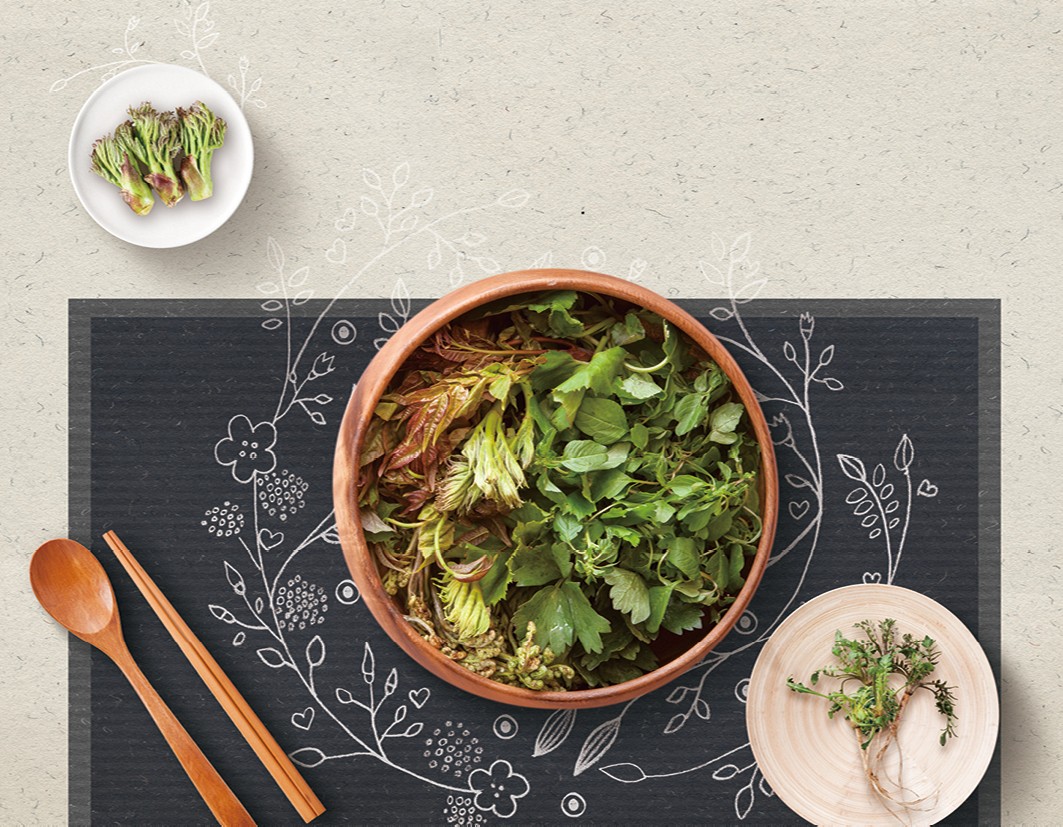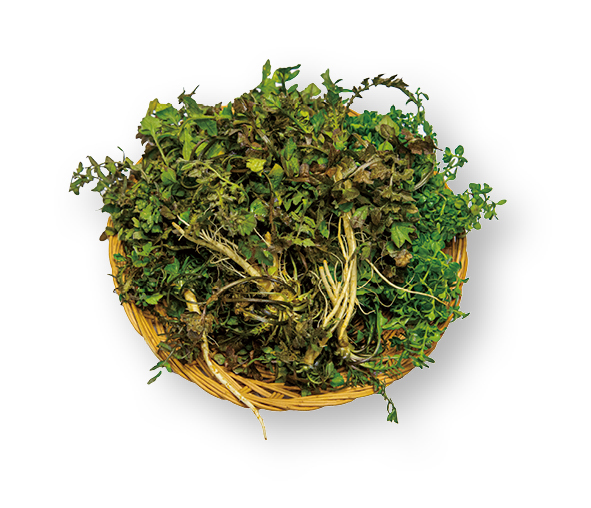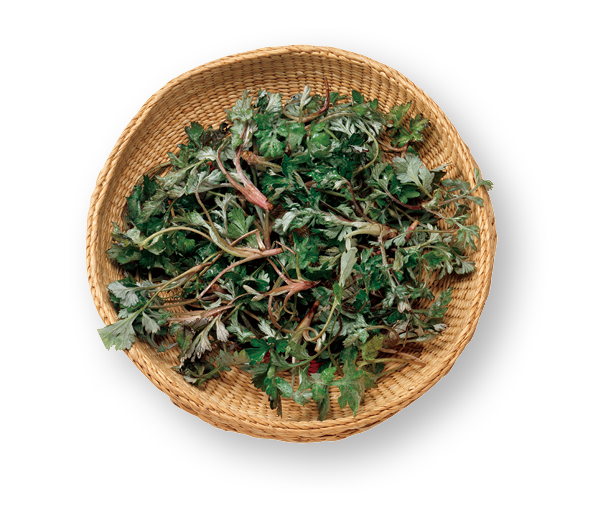한식 읽기 좋은 날
Vol 49. Namul, Food for People, Food That Spares
Spring Namul, a Must-have in the Spring Season
Tasty Road
With the evolution of cultivation methods and the development of distribution and logistics, the concept of “seasonal” has been fading lately. However, there are ingredients that reveal their true nature only when they are consumed at the right time. This article will introduce the representative namul(wild edible greens) that should not be missed in the spring, and their taste, nutrition, and usage methods that can be consumed fully if eaten at this time of the year.

Sweet and Spicy Dallae That Awakens the Palate
Dallae(wild chive) is native to East Asia, such as Korea and China, and grown mainly in the wild. It resembles the nutrition of garlic so much that it is called “garlic from the mountains.” The rich taste and aroma of dallae, which offers the piquant flavor of garlic, the spiciness of green onion, and the sweetness of onion, has the charm of driving away drowsy spring fatigue and reviving the sense of taste that was lost.
The unique taste and scent of dallae come from a component called “allicin,” which has refection, and an energy restoration effect, thus boosting the immune system of our body that cannot adapt to the changing environment from winter to spring. As an alkaline food containing a large amount of calcium, dallae can be helpful in improving the constitution of people nowadays, especially those who have been acidified by wrong eating habits. Moreover, it contains a variety of vitamins and minerals, and is particularly good for preventing anemia as it contains plenty of iron. It is a better ingredient when consumed with pork, because it helps increase the activity of vitamin B1 contained in pork, and lower cholesterol, which is caused by eating meat.
On a drowsy spring day when you have no appetite, make doenjangguk(soybean paste soup) with dallae or seasoned salad with other vegetables to bring back your appetite. Since dallae eliminates the pungency of doenjang(soybean paste), anyone can make fragrant doenjangguk, regardless of one’s cooking skills. Also, if you mix it with bomdong(fresh winter cabbage) or cucumber, it will make an excellent muchim(salad) dish on its own, and if you add it to a meat dish, it will balance out the meat’s richness. Dallaejang(wild chive soy sauce), made by adding chopped dallae, vinegar, sugar, and sesame salt to soy sauce, is a versatile sauce that enhances the flavor of bibimbap when you add it. Also, if you grill a few pieces of laver and have it with fragrant dallaejang and rice, you will have a delicious meal even without a side dish.

Naengi with Its Unique Texture and Deep Flavor of Roots
Naengi(shepherd’s purse) is a very common spring vegetable with very strong vitality and fertility. Depending on the region, it is also called nasanggu, nasaengi, nasungge, nasi, etc., and just by looking at the variety of the names, you can guess how much naengi is loved by the Korean people.
Naengi is usually eaten as a soup to taste the flavor of spring. It is also used in juk(porridge), jeon(pan-fried battered meat, fish or vegetable), kimchi, etc. Since it has a strong and rich aroma and the unique texture of the root is maintained even after boiling for a long time, it is also used for deep-fried dishes.
In Oriental medicine, the roots, leaves, stems, and seeds of naengi are dried and used as medicine. The root is called “jaechae” and is used to help digestion, while the seeds are called “seokmyungja,” and have the effect of strengthening the five organs and brightening the eyes. The stems and leaves are dried and burnt to be used for the symptoms of bloody stool.
Naengi has fine roots, so the process of washing and trimming it is very particular. If you don't wash the dirt off the fine roots properly, the food may have an earthy smell. Considering this cumbersome, people remove the root altogether and use only the stem and leaves, but it is the same as throwing away the roots of ginseng, which has high medicinal properties, and eating only the stems. Naengi’s unique aroma and flavor can be felt more strongly through the root, so it is recommended to wash it thoroughly with water several times, and eat the root. Naengi is an alkaline crop rich in protein and vitamins, so if eaten frequently, it helps improve the acidified constitution. Moreover, it is rich in vitamins A, B1, and C, so it is good for boosting one’s energy and relieving fatigue and spring fatigue. It is also rich in minerals, such as calcium, potassium, phosphorus, and iron, so let’s take advantage of the taste and nutrition of naengi by using it in various dishes in the spring.

Dureup with a Bitter Charm That Clears Your Head
As spring approaches, we feel drowsy with spring fatigue. Awakening that drowsiness is the characteristics of spring namul(wild greens) with a unique aroma and flavor. Dureup(fatsia shoot) is no exception as its unique aroma and bitter taste stimulate your palate. At first, you shake your head at its strong smell, but once you eat it, you will fall for its subtle addictiveness.
Dureup, which is regarded as the best of spring namul, is divided into chamdureup, which is a fatsia shoot, ddangdureup, a shoot grown in the ground, and gaedureup, a shoot of thorny tree(kalopanax). Tree dureups are mainly grown in Gangwon-do, and ddangdureups are mainly grown in Gangwon-do and Chungcheong-do. In Oriental medicine, dureup is known as “mokduchae,” which is especially good for people who have trouble waking up in the morning or studying for exams. This is because of the large amount of saponin contained in dureup. Since this ingredient is comparable to ginseng and wild ginseng, it has anti-cancer, anti-inflammatory, and antioxidant effects, prevents diabetes by lowering blood sugar and blood lipids, and activates cerebral activity to relieve mental fatigue. It is also rich in vitamin A, which has a good effect on various diseases.
It is common to collect short, blunt shoots that sprout in the spring, lightly blanch them in boiling water, toss them in chogochujang(sweet and sour red chili paste), or dip them. At this time, you need to boil or blanch dureup in water to remove the bitter taste and toxicity. Blanched dureup is skewered together with beef to make dureupjeok(dureup and beef skewers) or kimchi, fried dish, salad, etc. If you want to keep it for a long time, you can pickle it in salt, etc., or freeze it. The bitter taste that arouses the palate in the spring is stronger in gaedureup than chamdureup.

Ssuk Presenting the Youthful Spring
Ssuk(mugwort) is a wild green with a long history with the Korean people enough to appear in <The Myth of Dangun>. It can be found all over Korea, and when the mountains and fields are thick with the aroma of ssuk, you know that the spring season is in full swing. The unique smell of ssuk is due to the oil component called “cineole,” which has excellent immune and detoxifying effects that suppress the growth of harmful bacteria in the body. Moreover, it promotes the secretion of gastric juice to help in digestion, and helps manage spring fatigue.
In addition to cineole, ssuk has a variety of nutrients to be counted as one of the three major plants to prevent adult diseases, along with garlic and carrots. Rich in vitamins and minerals, such as vitamins B1 and B6, iron, calcium, potassium, and phosphorus, it promotes carbohydrate and energy metabolism in the body, detoxifies, relieves fatigue, and helps generate energy. It is also effective in relieving back pain and neuralgia. It is also rich in vitamins C and A, so it is good for preventing colds in the changing seasons, and since it removes free radicals, it helps with antioxidant action, anti-aging, and strengthening immunity. Potassium contained in ssuk purifies the blood, improves the constriction and relaxation of blood vessels, and lowers cholesterol levels, so it is effective in preventing hypertension and arteriosclerosis. The tannin component of ssuk is known to prevent cell aging and can have a strong anticancer effect. In Oriental medicine, ssuk is called “aeyeop,” and its medicinal effects were highly regarded. According to <Donguibogam>, it has a warm nature, and if taken for a long time, it strengthens the stomach, stimulates appetite, and is good for liver detoxification.
For medicinal purposes, it was considered that the most effective ingredients were collected and dried during Dano(the fifth day of the fifth month of the lunar year) in May. The tastiest and best ssuk has the light green stalk that sprouts in early spring. If the color of the leaves is dark, the bitter taste is strong, and the texture is not good. Since the ancient times, ssuk has been used in rice cakes by kneading its leaves and non-glutinous rice flour together to make jeolpyeon(patterned rice cake), and eating them on the day of Dano, because putting ssuk into rice cakes is good for nutrition as it supplements the lack of fat, fiber, and calcium in rice. Moreover, it goes well with various soups and stews, such as dodarissukguk(flounder and mugwort soup) and ssuk doenjanjjigae(mugwort soybean paste stew), and is also used for ssukbuchimgae(pan-fried mugwort pancake) and ssukcha(mugwort tea). Ssuk has a strong aroma and flavor, so it is best to boil it and soak it in water overnight before eating, and if it is dried, it can be eaten all year round.


 한국어
한국어
 English
English






